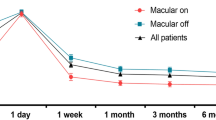Abstract
Purpose
To perform ultrasonographic evaluation of the preoperative status of the posterior vitreoretinal interface in phakic patients undergoing surgery for retinal detachment (RD) with flap tear(s) and to investigate its relationship with postoperative anatomic and visual acuity outcomes.
Methods
A prospective, consecutive case series including 50 phakic eyes of 49 patients with retinal detachment and flap tear(s) undergoing retinal detachment surgery by a single vitreoretinal surgeon, who was unaware of the patient’s preoperative B-scan ultrasonographic findings. Main outcome measures were comparisons between patients with partial versus complete posterior vitreous detachment (PVD) of primary retinal reattachment rates (retinal reattachment with a single surgical procedure), rates of retinal reattachment at month 12, and visual acuity outcomes at month 12.
Results
Partial PVD was observed in 22 (44%) eyes and complete PVD in 28 (56%) eyes. Eighteen eyes underwent pneumatic retinopexy, 15 underwent scleral buckling, and 17 underwent pars plana vitrectomy. Retinal reattachment with a single surgical procedure was achieved in 76% (38/50) of eyes, including 54.5% (12/22) of eyes with partial PVD at baseline and 92.9% (26/28) of eyes with complete PVD at baseline (P < 0.01). Stratification by type of surgical intervention demonstrated a significantly higher rate of primary anatomic success for pneumatic retinopexy among patients with complete PVD compared to partial PVD (P = 0.02). Retinal reattachment at month 12 was achieved in 100% (50/50) of eyes. At last follow-up, the mean (±SD) number of interventions was 1.70 (±1.10) for patients with partial PVD at baseline and 1.10 (±0.30) for patients with complete PVD (P < 0.01). There was no significant difference among the groups in mean change in visual acuity from baseline to month 12, nor in the distribution of visual acuities at month 12.
Conclusions
In phakic patients with retinal detachment and flap tear(s), a higher primary anatomic success rate may be associated with the presence of a complete PVD compared to a partial PVD. Subgroup analysis suggests that the presence of partial PVD at baseline might influence negatively the primary anatomic success rate, particularly for eyes undergoing pneumatic retinopexy.

Similar content being viewed by others
References
Gonin J (1934) Le décollement de la rétine: Pathogénie-traitement. Librairie Payot and Cie, Lausanne p 53–117
Sigelman J (1980) Vitreous base classification of retinal tears: clinical application. Surv Ophthalmol 25:59–74
Wilkinson CP (2000) Evidence-based analysis of prophylactic treatment of asymptomatic retinal breaks and lattice degeneration. Ophthalmology 107:12–18
Wilkinson CP (1995) Phakic retinal detachments in the elderly. Retina 15:220–223
Lois N, Wong D (2003) Pseudophakic retinal detachment. Surv Ophthalmol 48:467–487
Zaidi AA, Alvarado R, Irvine A (2006) Pneumatic retinopexy: success rate and complications. Br J Ophthalmol 90:427–428
Miki D, Hida T, Hotta K, Shinoda K, Hirakata A (2001) Comparison of scleral buckling and vitrectomy for retinal detachment resulting from flap tears in superior quadrants. Jpn J Ophthalmol 45:187–191
Tornambe PE (1997) Pneumatic retinopexy: the evolution of case selection and surgical technique. A 12-year study of 302 eyes. Trans Am Ophthalmol Soc XCV:551–578
Afrashi F, Akkin C, Egrilmez S, Erakgun T, Mentes J (2006) Anatomic outcome of scleral buckling surgery in primary rhegmatogenous retinal detachment. Int Ophthalmol Sep 7;[Epub ahead of print]
Capeans C, Lorenzo J, Santos L et al (1998) Comparative study of incomplete posterior vitreous detachment as a risk factor for proliferative vitreoretinopathy. Graefes Arch Clin Exp Ophthalmol 236:481–485
Byer NE (1995) Posterior vitreous detachment as a risk factor for retinal detachment [author’s reply]. Ophthalmology 102:528
Tornambe PE, Hilton GF, The Retinal Detachment Study Group (1989) A multicenter randomized controlled clinical trial comparing pneumatic retinopexy with scleral buckling. Ophthalmology 96:772–784
Arzabe CW, Akiba J, Jalkh AE et al (1991) Comparative study of vitreoretinal relationships using biomicroscopy and ultrasound. Graefes Arch Clin Exp Ophthalmol 229:66–68
Sun X, Zhang X, Huang L (1999) Relationship between the prognosis of retinal detachment in emmetropic eyes and vitreous changes. Chin J Ophthalmol 35:409–412
Sonoda KH, Sakamoto T, Enaida H et al (2004) Residual vitreous cortex after surgical posterior vitreous separation visualized by intravitreous triamcinolone acetonide. Ophthalmology 111:226–230
Scott JD (1972) Concepts in vitreous traction. Mod Probl Ophthalmol 10:166–171
Hovland KR (1978) Vitreous findings in fellow eyes of aphakic retinal detachment. Am J Ophthalmol 86:350–353
Mastropasqua L, Carpineto P, Ciancaglini M et al (1999) Treatment of retinal tears and lattice degenerations in fellow eyes in high risk patients suffering retinal detachment: a prospective study. Br J Ophthalmol 83:1046–1049
Acknowledgements
The authors gratefully acknowledge the contributions of Drs. Tiago and Renata Bisol to the statistical analysis.
Author information
Authors and Affiliations
Corresponding author
Additional information
The authors have full access to all the data in the study and agree to allow Graefe’s Archive for Clinical and Experimental Ophthalmology to review our data upon request.
Financial interest: F. Rezende, none; M. Kapusta, none; R. Costa, none; I. Scott, none.
An erratum to this article can be found at http://dx.doi.org/10.1007/s00417-007-0664-8
Rights and permissions
About this article
Cite this article
Rezende, F.A., Kapusta, M.A., Costa, R.A. et al. Preoperative B-scan ultrasonography of the vitreoretinal interface in phakic patients undergoing rhegmatogenous retinal detachment repair and its prognostic significance. Graefes Arch Clin Exp Ophthalmol 245, 1295–1301 (2007). https://doi.org/10.1007/s00417-007-0541-5
Received:
Revised:
Accepted:
Published:
Issue Date:
DOI: https://doi.org/10.1007/s00417-007-0541-5




